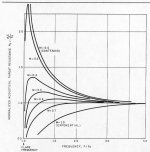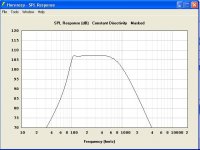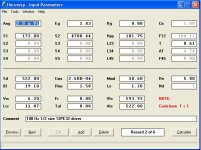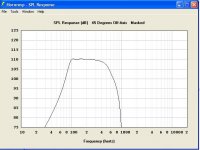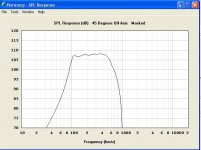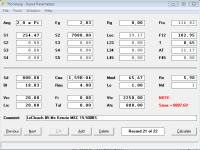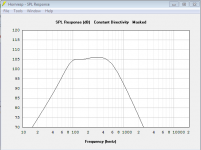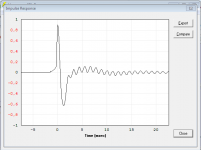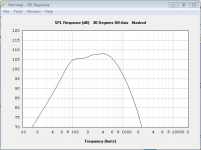Of all examples with a 20" mouth 5.11-D appears to be the one with the fewest ripples and the lowest amplitude peaks. Based on the information provided I would summarize that for a given mouth size and cutoff the shortest horn will have the least "honk"?
Using the System Designer in Hornresp, it gives a 100 Hz 2Pi Le Cleach horn as 122 cm long for this 12" driver, which is longer than the hyp-ex. It also gives a warning that the mouth is too small for the full flare of the horn.
🙁 Making a good horn for this driver is perplexing, I'm not having any luck getting extension or good off axis response that fits your requirements.
Neo Dan, do you look for off-axis respons in Hornresp, or do you use another program? In case of Hornresp, do you then enter the "directivity"? Are you then purely looking at the SPL curve, or anything else?🙁 Making a good horn for this driver is perplexing, I'm not having any luck getting extension or good off axis response that fits your requirements.
Hello NEO Dan,
You have to differenciate 3 intervals of frequency in the behaviour of the roll back at the mouth:
1) when wavelength is larger than the size of the roll back,
2) when wavelength is of the same scale than the size of the roll back
3) when wavelength is smaller than the size of the roll back.
In case 1 the influence of the roll back is mainly on the throat impedance which is more constant and resistive with the roll back. As directivity is negligeible at low frequency the shape of the wavefront outside of the mouth will be quasi spherical but at those low frequencies (large wavelengths) it will be similar with a truncated horn.
In case 2 (median frequency) the influence of roll back will be either on the throat impedance and how the mouth diffract (complete roll back = minimum diffraction). In that range of frequency the roll back has major importance.
In case 3 because of evenly distributed high order modes and continuous diffraction along the curved profile of the Le Cléac'h horn, directivity will very progressively rise. At high frequency the axial radiation lobe is nearly not influenced by the roll back at mouth.
So when we speak about the relation between the roll back at mouth and the influence of teh room we have to take in account the interval of frequency inside which the horn will be used.
Best regards from Paris, France
Jean-Michel Le Cléac'h
it still seems that the performance of the roll back may be more easily disturbed by influence external to the horn.
You have to differenciate 3 intervals of frequency in the behaviour of the roll back at the mouth:
1) when wavelength is larger than the size of the roll back,
2) when wavelength is of the same scale than the size of the roll back
3) when wavelength is smaller than the size of the roll back.
In case 1 the influence of the roll back is mainly on the throat impedance which is more constant and resistive with the roll back. As directivity is negligeible at low frequency the shape of the wavefront outside of the mouth will be quasi spherical but at those low frequencies (large wavelengths) it will be similar with a truncated horn.
In case 2 (median frequency) the influence of roll back will be either on the throat impedance and how the mouth diffract (complete roll back = minimum diffraction). In that range of frequency the roll back has major importance.
In case 3 because of evenly distributed high order modes and continuous diffraction along the curved profile of the Le Cléac'h horn, directivity will very progressively rise. At high frequency the axial radiation lobe is nearly not influenced by the roll back at mouth.
So when we speak about the relation between the roll back at mouth and the influence of teh room we have to take in account the interval of frequency inside which the horn will be used.
Best regards from Paris, France
Jean-Michel Le Cléac'h
Last edited:
Sans Horn, Maybe?
In these cases (Dm = 20"), superior performance can be obtained, sans the horn. The purpose of the charts is to illustrate the relationship of horn length to horn resonances. Had a larger mouth been chosen, the differences would be less pronounced. Also note for the example cited, the peek is occurring almost an octave above [fc]. Of all the finite examples given in both charts, only two qualify as worthwhile. They are long with large mouths.
If the horn sized to meet the mission is too large, your choices are four:
a) Bifurcate and bend (not fold) the horn neck (not bell) to reduce footprint length
b) Change the mission and raise [Fl] so a smaller horn may be used.
c) Just make it too small, and simply ignore the consequences.
d) Do not use a horn; the venue does not support its use.
Of all the all horn systems I have encountered (audited) only the Klipsch Jubilee comes close to filling the at home mission in a manner approaching optimal for that setting. A horn-farm is a hard-sell in a domestic setting, except when placed in a garage, basement or other appropriate space.
Regards,
WHG
Of all examples with a 20" mouth 5.11-D appears to be the one with the fewest ripples and the lowest amplitude peaks. Based on the information provided I would summarize that for a given mouth size and cutoff the shortest horn will have the least "honk"?
In these cases (Dm = 20"), superior performance can be obtained, sans the horn. The purpose of the charts is to illustrate the relationship of horn length to horn resonances. Had a larger mouth been chosen, the differences would be less pronounced. Also note for the example cited, the peek is occurring almost an octave above [fc]. Of all the finite examples given in both charts, only two qualify as worthwhile. They are long with large mouths.
If the horn sized to meet the mission is too large, your choices are four:
a) Bifurcate and bend (not fold) the horn neck (not bell) to reduce footprint length
b) Change the mission and raise [Fl] so a smaller horn may be used.
c) Just make it too small, and simply ignore the consequences.
d) Do not use a horn; the venue does not support its use.
Of all the all horn systems I have encountered (audited) only the Klipsch Jubilee comes close to filling the at home mission in a manner approaching optimal for that setting. A horn-farm is a hard-sell in a domestic setting, except when placed in a garage, basement or other appropriate space.
Regards,
WHG
I have been working just in Hornresp. I do lots of peeking at the off-axis response (Ctrl+R)in SPL Response) and most of the other tools too but not nearly as often. The size limitation is quite small relative to the required LF performance so I've tried to make the most of it.Neo Dan, do you look for off-axis respons in Hornresp, or do you use another program? In case of Hornresp, do you then enter the "directivity"? Are you then purely looking at the SPL curve, or anything else?
Hi Jmmlc,Hello NEO Dan,
You have to differenciate 3 intervals of frequency in the behaviour of the roll back at the mouth:
1) when wavelength is larger than the size of the roll back,
2) when wavelength is of the same scale than the size of the roll back
3) when wavelength is smaller than the size of the roll back.
In case 1 the influence of the roll back is mainly on the throat impedance which is more constant and resistive with the roll back. As directivity is negligeible at low frequency the shape of the wavefront outside of the mouth will be quasi spherical but at those low frequencies (large wavelengths) it will be similar with a truncated horn.
In case 2 (median frequency) the influence of roll back will be either on the throat impedance and how the mouth diffract (complete roll back = minimum diffraction). In that range of frequency the roll back has major importance.
In case 3 because of evenly distributed high order modes and continuous diffraction along the curved profile of the Le Cléac'h horn, directivity will very progressively rise. At high frequency the axial radiation lobe is nearly not influenced by the roll back at mouth.
So when we speak about the relation between the roll back at mouth and the influence of teh room we have to take in account the interval of frequency inside which the horn will be used.
Best regards from Paris, France
Jean-Michel Le Cléac'h
Thank you for the additional insight.
In these cases (Dm = 20"), superior performance can be obtained, sans the horn. The purpose of the charts is to illustrate the relationship of horn length to horn resonances. Had a larger mouth been chosen, the differences would be less pronounced. Also note for the example cited, the peek is occurring almost an octave above [fc]. Of all the finite examples given in both charts, only two qualify as worthwhile. They are long with large mouths.
If the horn sized to meet the mission is too large, your choices are four:
a) Bifurcate and bend (not fold) the horn neck (not bell) to reduce footprint length
b) Change the mission and raise [Fl] so a smaller horn may be used.
c) Just make it too small, and simply ignore the consequences.
d) Do not use a horn; the venue does not support its use.
Of all the all horn systems I have encountered (audited) only the Klipsch Jubilee comes close to filling the at home mission in a manner approaching optimal for that setting. A horn-farm is a hard-sell in a domestic setting, except when placed in a garage, basement or other appropriate space.
Regards,
WHG
I think it's time for you to put forth a design for this thread that offers the superior performance I seem to have failed to achieve. If it's not on the table maybe it's hiding in between the couch cushions? Maybe I'm about to learn something. This usually happens when I am short-sighted, focused on the wrong thing, or make a mistake. The sad part is when I don't take notice and therefor I fail to learn the lesson. So have at it already!🙂
This is where I am at:
Code:
ID=28.00
Ang=2.0 x Pi
Eg=28.28
Rg=0.00
Fta=119.84
S1=254.47
S2=7088.00
Lec=32.96
F12=182.95
S2=0.00
S3=0.00
L23=0.00
T=1.00
S3=0.00
S4=0.00
L34=0.00
AT=17.20
S4=0.00
S5=0.00
L45=0.00
F45=0.00
Sd=800.00
Bl=18.83
Cms=1.59E-04
Rms=4.00
Mmd=65.67
Le=1.00
Re=5.90
Nd=1
Vrc=20.00
Lrc=20.00
Ap=0.00
Lpt=0.00
Vtc=2250.00
Atc=800.00
Pmax=100
Xmax=5.0
Comment=McKenzie LEC4So within the requirement that S2=<7088 and target -3dB 80Hz to 5-600Hz lets see what you've got.
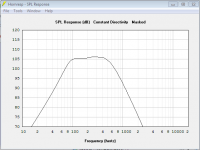
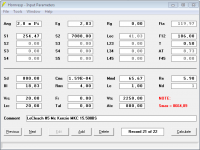
I have altered the lenght a little. Only F12 and T is changed. Is there any disadvantages to use T=0,5 rather than T=1? This horn will be 41cm instead of 32cm. I have no clue to what the differences might be, other than that it will easier integrate with a Lecleach midhorn that will be approximatly 38cm.
I have had better sound quality results staying between T = 0.62 and 0.85
If you are using an under sized mouth, then the low T values will have higher peak changes in throat impedance. In other words, the horn may have a shouting or peaky sound to it. While it can make the horn sound dynamic somewhat, it becomes fatiguing very quickly.
If you are using an under sized mouth, then the low T values will have higher peak changes in throat impedance. In other words, the horn may have a shouting or peaky sound to it. While it can make the horn sound dynamic somewhat, it becomes fatiguing very quickly.
Attachments
Thanks, JHL! So the question here is really if my mouth size is undersized. How do I know that? I have a 7088cm2 LeCleach, so I would guess it's big enough? The T can be changed a little further.
🙁 Making a good horn for this driver is perplexing, I'm not having any luck getting extension or good off axis response that fits your requirements.
The SPL response is really nice, but it is omnidirectional in 1/2 space up to the cutoff of 500Hz.
Attachments
🙁 Making a good horn for this driver is perplexing, I'm not having any luck getting extension or good off axis response that fits your requirements.
Thanks for pointing out the ctrl - r feature in Hornresp!
The first chart is the 1/2 size horn in 1/4 space. The second is the same horn in 1/2 size space. I think it's still pretty good. The -3dB points are still around 500 Hz, which is the intended upper limit for this horn.
Attachments
Any reason why you use 45 degrees off-axis?Thanks for pointing out the ctrl - r feature in Hornresp!
The first chart is the 1/2 size horn in 1/4 space. The second is the same horn in 1/2 size space. I think it's still pretty good. The -3dB points are still around 500 Hz, which is the intended upper limit for this horn.
NEO Dan: thanks for the ctrl-r...must try that later!
Any reason why you use 45 degrees off-axis?
NEO Dan: thanks for the ctrl-r...must try that later!
I guess because I'd be happy with a 90 degree included angle.
Hmmm...I may be a little slow here, but care to explain that? (trying to learn 🙂)I guess because I'd be happy with a 90 degree included angle.
Hmmm...I may be a little slow here, but care to explain that? (trying to learn 🙂)
45 degrees off axis is a total angle of 90 degrees for the complete radiation pattern.
Anyway, I have not modeled your driver in a horn, sorry. I don't have time to enter all that data right now. I'm not very experienced with building horns anyway.
Aha..then it's clearer. You don't need to simulate my horn, but feel free to discuss yours here...no problem! If we all can learn something from different horns, it's all good 🙂45 degrees off axis is a total angle of 90 degrees for the complete radiation pattern.
Anyway, I have not modeled your driver in a horn, sorry. I don't have time to enter all that data right now. I'm not very experienced with building horns anyway.
Hi Guys,
Glad you are having fun with Hornresp.
IIRC an average setup probably is ~15-20 degrees, but that can easily vary beyond that range. The thing I would choose to focus on is the amount of change and the shape of the response especially through the range of the crossover. It looks like Dirk put some time in on his design - sorry Dirk but it looks like your not quite done yet. 😛 You might have thought I did you a favor in showing you that keystroke combo, but down that path is madness


You can thank me later after you get done
 me
me
Glad you are having fun with Hornresp.
IIRC an average setup probably is ~15-20 degrees, but that can easily vary beyond that range. The thing I would choose to focus on is the amount of change and the shape of the response especially through the range of the crossover. It looks like Dirk put some time in on his design - sorry Dirk but it looks like your not quite done yet. 😛 You might have thought I did you a favor in showing you that keystroke combo, but down that path is madness



You can thank me later after you get done

 me
meHi Guys,
Glad you are having fun with Hornresp.
IIRC an average setup probably is ~15-20 degrees, but that can easily vary beyond that range. The thing I would choose to focus on is the amount of change and the shape of the response especially through the range of the crossover. It looks like Dirk put some time in on his design - sorry Dirk but it looks like your not quite done yet. 😛 You might have thought I did you a favor in showing you that keystroke combo, but down that path is madness

You can thank me later after you get done
me
Thanks!!!!..... I think.... 😀
- Status
- Not open for further replies.
- Home
- Loudspeakers
- Multi-Way
- Hyperbolic mid/upper bass horn
